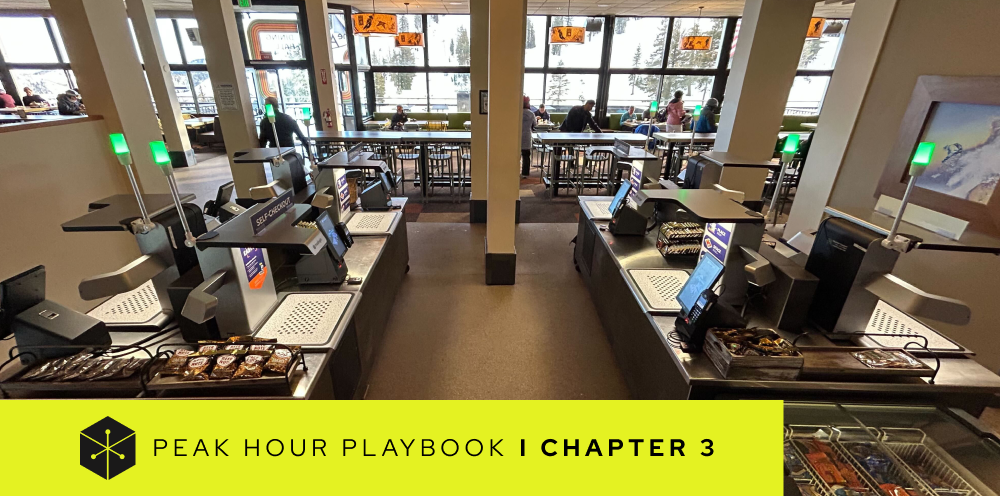Throughput Maximization in Action: The Palisades Tahoe Model

When your peak is predictable and unavoidable, you don’t just solve for speed, you engineer it. Palisades Tahoe, a high-altitude resort with over 70% of its food and beverage (F&B) revenue earned within a three-hour lunch window, offers a compelling model for peak management through strategic capacity deployment.
The Peak Problem Gets Real at Scale
In retail and hospitality, research consistently shows that faster service is associated with higher revenue. Food-service studies show that diners are increasingly willing to trade wait time for service quality and cost, with many opting to abandon long lines entirely.
In this context, standing still is falling behind, especially when your crowd comes all at once.
Why Kiosks Scale Where Registers Stall

Conventional registers require one cashier per lane. Adding lanes means hiring and scheduling cashiers, which is an inefficient and costly process. Kiosks flip that model: one or two staff can manage many machines, and each transaction happens in seconds.
For Palisades Tahoe, this meant scaling through capacity, not staff:
- 26 kiosks across seven venues
- Wait times slashed from ~15 minutes to under 2
- Peak-day sales climbed up to 40%
That’s faster flow, higher revenue, and better staff productivity—all without expanding the kitchen or ballooning labor costs.
Planning for Throughput: What Palisades Got Right
Operators considering the throughput-maximization route can learn from Palisades:
- Size your fleet by peak load: Map guest and transaction volumes during your busiest window to determine the optimal kiosk count.
- Design floor flow intentionally: Arrange kiosks to channel guests through one, two, or three checkout lanes.
- Optimize staffing ratios: Track kiosks per staff ratio, ideally 3-4 kiosks per employee, to ensure timely technical assistance without excess headcount.
- Educate guests upfront: During early deployment, station guides should be positioned near kiosks to triage issues and reinforce self-service norms.
- Monitor throughput in real time: Dashboards to track transaction pace—adjust machine placement or staffing dynamically as needed.
With this approach, the goal isn’t just peak readiness; it’s consistent throughput performance across every lunch rush.
When Throughput Makes Sense and When It Doesn’t
Throughput maximization is most effective in environments where operators encounter large, predictable peaks that are challenging to mitigate through other means. Resorts like Palisades Tahoe fit this profile perfectly. Most guests want to eat at roughly the same time, and few are willing to schedule their lunch hours in advance. The same holds for corporate campuses with fixed lunch windows, stadium concessions during halftime, and large student dining halls between classes. In these settings, operators can confidently plan for the surge and invest in kiosk capacity that directly matches demand.
Physical space also plays a key role. Throughput maximization depends on having sufficient space to install multiple kiosks and design the customer flow accordingly. Operators with enough floor space can convert square footage into transaction capacity, eliminating the need for additional staffing by utilizing hardware that scales.
But not every operation lends itself to this model. If peak volumes fluctuate unpredictably or space is limited, adding more kiosks may not be a practical solution. Some operators may also prefer greater control over kitchen pacing, especially when dealing with complex, made-to-order menus or highly variable guest schedules. In such cases, a demand-smoothing strategy centered on mobile ordering and self-service ordering tablets can provide a more precise way to manage both customer flow and kitchen workload.
The Takeaway
Throughput maximization is about engineering your operation around predictable demand peaks. It’s a high-speed, high-capacity strategy designed to crush the curve. Palisades Tahoe shows how combining volume, space planning, and kiosk tech can turn a challenge into a clear advantage.
In the next post, we’ll explore a different path: how Cleveland Clinic uses mobile and Byte to decentralize peak management—and what that looks like in practice.

